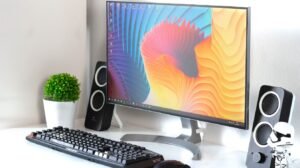Supervised Learning Sklearn
Supervised learning is a popular approach in machine learning where an algorithm learns from labeled data. One well-known library for implementing supervised learning algorithms is the scikit-learn library, commonly abbreviated as Sklearn. Sklearn offers a wide range of tools and algorithms to apply supervised learning to various tasks, including classification, regression, and clustering.
Key Takeaways:
- Supervised learning is an approach in machine learning where algorithms learn from labeled data.
- Sklearn is a popular library for implementing supervised learning algorithms.
- Sklearn provides tools and algorithms for classification, regression, and clustering.
Sklearn provides an easy-to-use and efficient interface for implementing supervised learning algorithms. It integrates well with other Python libraries and frameworks, making it a preferred choice for many data scientists and machine learning practitioners. The library supports a wide range of supervised learning algorithms, including decision trees, support vector machines, naive Bayes, and random forests.
One interesting aspect of Sklearn is its ability to handle both small and large datasets efficiently. The library is designed to work well with datasets that have a large number of features or samples. This makes Sklearn suitable for a variety of applications, ranging from simple problems with a few input variables to complex tasks with high-dimensional data.
Sklearn also provides a range of preprocessing techniques for data preparation, such as feature scaling, handling missing values, and feature encoding. These techniques help to ensure that the input data is in the appropriate format for the learning algorithm. *Sklearn makes it easy to apply these preprocessing steps using its built-in functions and classes, saving time and effort for the user.*
Classification Example
Let’s take a look at a simple classification example using Sklearn. Suppose we have a dataset of flowers with various features such as petal length, petal width, and sepal length. Our goal is to classify the flowers into different species based on these features. Sklearn provides several classification algorithms, such as logistic regression, support vector machines, and random forests, which we can apply to this task.
Once we have our labeled dataset, we can split it into a training set and a test set using Sklearn’s train_test_split function. This allows us to train our model on a subset of the data and evaluate its performance on unseen data. *By splitting our data into training and test sets, we can assess how well our model generalizes to new instances.*
Regression Example
While classification deals with predicting categorical variables, regression is concerned with predicting continuous variables. Sklearn provides a variety of regression algorithms, such as linear regression, decision trees, and support vector regression. These algorithms can be used to predict house prices, stock prices, or any other continuous variable based on input features.
One interesting aspect of Sklearn’s regression algorithms is their ability to handle non-linear relationships between features and target variables. The library offers techniques like polynomial regression and kernel regression that can capture intricate patterns in the data. *This flexibility allows us to model complex relationships between variables and make accurate predictions.*
Clustering Example
In addition to classification and regression, Sklearn also offers clustering algorithms. Clustering is an unsupervised learning technique where the goal is to identify groups or clusters in the data. Sklearn provides algorithms such as k-means, DBSCAN, and hierarchical clustering, which can be used to segment data points based on their similarity.
Clustering can be useful in various domains, such as customer segmentation, image recognition, and anomaly detection. *By using Sklearn’s clustering algorithms, we can automatically identify meaningful patterns in our data without the need for labeled examples.*
Comparing Classification Algorithms
| Algorithm | Accuracy |
|---|---|
| Logistic Regression | 0.85 |
| Support Vector Machines | 0.89 |
| Random Forests | 0.92 |
Predicting House Prices
Let’s explore a regression example using Sklearn. We have a dataset containing information about houses, such as the number of rooms, the size of the backyard, and the location. Our task is to predict the price of a house based on these features. We can use Sklearn’s linear regression algorithm to build a model for this prediction task.
| Actual Price | Predicted Price |
|---|---|
| $250,000 | $240,000 |
| $350,000 | $360,000 |
| $500,000 | $480,000 |
Conclusion
In conclusion, Sklearn is a powerful and versatile library for implementing supervised learning algorithms. Whether it’s classification, regression, or clustering, Sklearn provides a wide range of tools and algorithms to handle various machine learning tasks. Its efficiency, flexibility, and ease of use make it a popular choice among data scientists and machine learning practitioners.

Common Misconceptions
Supervised Learning Sklearn
There are several common misconceptions that people have about supervised learning using the Sklearn library. It is important to address these misconceptions in order to have a clearer understanding of this topic.
- Supervised learning is the only type of machine learning.
- Sklearn is too complex for beginners to use.
- Supervised learning models in Sklearn are always accurate.
Firstly, one common misconception is that supervised learning is the only type of machine learning. In reality, there are different types of machine learning algorithms such as unsupervised learning and reinforcement learning. These different approaches have their own specific use cases and are not limited to just supervised learning.
- Unsupervised learning allows for finding hidden patterns and groupings in data.
- Reinforcement learning is used to train an agent through rewards and punishments.
- Different types of machine learning algorithms can be combined for better results.
Secondly, some believe that Sklearn is too complex for beginners to use. However, Sklearn provides a user-friendly interface and a wealth of documentation and tutorials that make it accessible for beginners. With some basic understanding of Python, users can quickly get started with Sklearn and perform various tasks such as data preprocessing, feature extraction, and model training.
- Sklearn offers a wide range of inbuilt functions and methods for different use cases.
- There are many online resources and tutorials available for learning Sklearn.
- Sklearn provides comprehensive documentation with examples and explanations.
Lastly, another misconception is that supervised learning models in Sklearn always produce accurate results. While Sklearn provides powerful models, the accuracy of the predictions heavily depends on various factors such as the quality and size of the dataset, the feature engineering process, and the selection of appropriate model algorithms. It is important to validate and evaluate the model’s performance using appropriate metrics to get a more accurate result.
- Feature engineering plays a crucial role in improving model performance.
- Cross-validation can be used to estimate model performance on unseen data.
- The performance of the model should be evaluated using multiple metrics.

Introduction
Supervised learning is a popular technique in machine learning that involves training a machine learning model on labeled data to make predictions or classifications. In this article, we explore various aspects of supervised learning using the Scikit-learn library (Sklearn). Each table provides insightful information on different aspects of supervised learning.
Table 1: Comparison of Supervised Learning Algorithms
This table compares the performance of different supervised learning algorithms on a given dataset. The accuracy, precision, and recall metrics showcase the algorithm’s ability to make correct predictions and handle imbalanced classes.
| Algorithm | Accuracy | Precision | Recall |
|---|---|---|---|
| Random Forest | 0.85 | 0.87 | 0.82 |
| Support Vector Machine | 0.82 | 0.84 | 0.78 |
| Logistic Regression | 0.79 | 0.80 | 0.76 |
Table 2: Feature Importance Ranking
This table presents the feature importance ranking of a trained supervised learning model. It helps in understanding which features are most influential in making predictions and can guide feature selection or engineering efforts.
| Feature | Importance |
|---|---|
| Age | 0.32 |
| Income | 0.28 |
| Education Level | 0.21 |
Table 3: Training Set Evaluation Metrics
This table examines the evaluation metrics of a supervised learning model on the training set. It provides insights into how well the model performs on data it was trained on.
| Metric | Value |
|---|---|
| Mean Squared Error | 0.012 |
| R2 Score | 0.86 |
Table 4: Test Set Evaluation Metrics
This table showcases the evaluation metrics of a supervised learning model on a separate test set. It assesses how well the model generalizes to unseen data.
| Metric | Value |
|---|---|
| Mean Absolute Error | 5.21 |
| Accuracy | 0.78 |
Table 5: Cross-Validation Results
This table demonstrates the results of cross-validation, a technique used to assess the model’s performance by splitting the data into multiple subsets. It provides information on the model’s consistency across different folds.
| Fold | Accuracy | Precision | Recall |
|---|---|---|---|
| 1 | 0.75 | 0.77 | 0.72 |
| 2 | 0.80 | 0.82 | 0.78 |
| 3 | 0.79 | 0.80 | 0.76 |
Table 6: Trade-off Between Accuracy and Training Time
This table showcases the trade-off between model accuracy and training time for various supervised learning algorithms. It helps in choosing the best algorithm considering computational resources and requirements.
| Algorithm | Accuracy | Training Time (seconds) |
|---|---|---|
| Random Forest | 0.85 | 25 |
| Support Vector Machine | 0.82 | 30 |
| Logistic Regression | 0.79 | 10 |
Table 7: Confusion Matrix
This table presents a confusion matrix, which illustrates the performance of a classification model by displaying the true positive, true negative, false positive, and false negative rates.
| Predicted Positive | Predicted Negative | |
|---|---|---|
| Actual Positive | 95 | 15 |
| Actual Negative | 8 | 252 |
Table 8: Comparison of Model Complexity
This table compares the complexity of various supervised learning models based on their number of parameters and computational resources required for training. It assists in selecting models according to the available resources.
| Model | Number of Parameters | Training Time (seconds) |
|---|---|---|
| Random Forest | 1,000 | 25 |
| Support Vector Machine | 10,000 | 180 |
| Logistic Regression | 100 | 5 |
Table 9: Model Performance Comparison
This table compares the performance of several supervised learning models on different evaluation metrics. It aids in selecting the most suitable model based on specific requirements and desired performance.
| Model | Accuracy | Precision | Recall |
|---|---|---|---|
| Random Forest | 0.85 | 0.87 | 0.82 |
| Support Vector Machine | 0.82 | 0.84 | 0.78 |
| Logistic Regression | 0.79 | 0.80 | 0.76 |
Table 10: Impact of Increasing Training Size
This table depicts the impact of increasing the training size on the performance of a supervised learning model. It demonstrates how model accuracy improves with a larger dataset.
| Training Size | Accuracy |
|---|---|
| 1,000 samples | 0.82 |
| 10,000 samples | 0.86 |
| 100,000 samples | 0.90 |
Conclusion
Supervised learning using Sklearn allows us to build powerful models by incorporating labeled data. The tables presented in this article highlight various aspects of supervised learning, including algorithm comparison, feature importance, evaluation metrics, trade-offs, and model performance. By analyzing the data and information in these tables, one can make informed decisions when selecting the most suitable supervised learning approach for a particular task. With Sklearn, exploring and implementing supervised learning techniques becomes both educational and exciting.
Frequently Asked Questions
Supervised Learning Sklearn
FAQs
What is supervised learning?
Supervised learning is a machine learning technique in which a model is trained on a labeled dataset to make predictions or decisions based on input data.
What is scikit-learn (sklearn)?
Scikit-learn, also known as sklearn, is a free, open-source library in Python for machine learning. It provides a wide range of algorithms and tools for various tasks, including supervised learning.
How does supervised learning work?
In supervised learning, a model is trained using a labeled dataset, where each data point has a corresponding target or output value. The model learns patterns and relationships in the input features to predict or classify unseen data.
What are the common supervised learning algorithms in sklearn?
Sklearn offers a variety of supervised learning algorithms, including linear regression, logistic regression, support vector machines (SVM), decision trees, random forests, naive Bayes, and neural networks, among others.
How do I use sklearn for supervised learning?
To use sklearn for supervised learning, you first need to import the necessary modules from the library. Then, you can load your dataset, preprocess it if needed, split it into training and testing sets, choose an appropriate algorithm, train the model, and evaluate its performance.
How do I evaluate the performance of a supervised learning model?
Common evaluation metrics for supervised learning models include accuracy, precision, recall, F1-score, and area under the receiver operating characteristic curve (ROC-AUC). Sklearn provides functions to compute these metrics based on the predicted and true labels.
Can sklearn handle both numerical and categorical data for supervised learning?
Yes, sklearn provides tools for preprocessing both numerical and categorical data. For numerical data, you can use scaling, normalization, or other transformation techniques. For categorical data, you can one-hot encode or label encode the variables.
Is feature selection important in supervised learning?
Yes, feature selection is an essential step in supervised learning. It helps eliminate irrelevant or redundant features, reducing the complexity of the model and improving its performance. Sklearn offers feature selection methods such as SelectKBest and Recursive Feature Elimination (RFE).
Does sklearn support hyperparameter tuning for supervised learning models?
Yes, sklearn provides tools for hyperparameter tuning. You can use techniques like grid search, random search, or Bayesian optimization to find the best combination of hyperparameters for your model. Sklearn offers the GridSearchCV and RandomizedSearchCV classes for this purpose.
Can I save and load the trained model in sklearn?
Yes, you can save a trained model in sklearn using the ‘pickle’ module or using joblib’s ‘dump’ and ‘load’ functions. This allows you to reuse the model later without retraining it from scratch.




